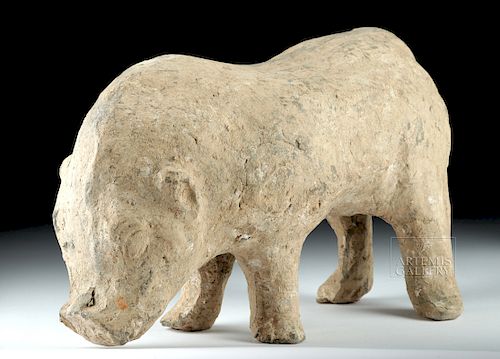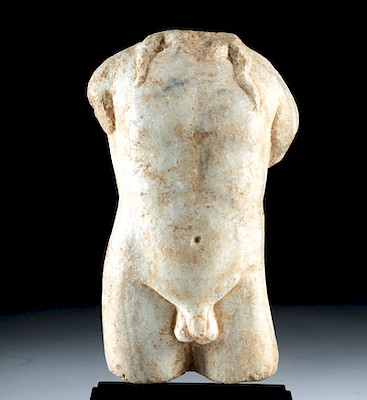Chinese Han Dynasty Terracotta Pig w/ TL
Lot 94b
About Seller
Artemis Fine Arts
686 S Taylor Ave, Ste 106
Louisville, CO 80027
United States
Selling antiquities, ancient and ethnographic art online since 1993, Artemis Gallery specializes in Classical Antiquities (Egyptian, Greek, Roman, Near Eastern), Asian, Pre-Columbian, African / Tribal / Oceanographic art. Our extensive inventory includes pottery, stone, metal, wood, glass and textil...Read more
Categories
Estimate:
$1,500 - $2,000
Absentee vs Live bid
Two ways to bid:
- Leave a max absentee bid and the platform will bid on your behalf up to your maximum bid during the live auction.
- Bid live during the auction and your bids will be submitted real-time to the auctioneer.
Bid Increments
| Price | Bid Increment |
|---|---|
| $0 | $25 |
| $300 | $50 |
| $1,000 | $100 |
| $2,000 | $250 |
| $5,000 | $500 |
| $10,000 | $1,000 |
| $20,000 | $2,500 |
| $50,000 | $5,000 |
| $100,000 | $10,000 |
| $200,000 | $20,000 |
About Auction
By Artemis Fine Arts
Dec 5, 2018
Set Reminder
2018-12-05 10:00:00
2018-12-05 10:00:00
America/New_York
Bidsquare
Bidsquare : DAY 1 | Classical Antiquities & Asian Art
https://www.bidsquare.com/auctions/artemis-gallery/day-1-classical-antiquities-asian-art-3698
Day 1 of an important 2-day auction featuring ancient and ethnographic art from around the world. Egyptian, Greek, Roman, Viking, Near Eastern plus Asian Art from China, Japan, Thailand, Vietnam, Burma, India, more. Artemis Fine Arts info@artemisgallery.com
Day 1 of an important 2-day auction featuring ancient and ethnographic art from around the world. Egyptian, Greek, Roman, Viking, Near Eastern plus Asian Art from China, Japan, Thailand, Vietnam, Burma, India, more. Artemis Fine Arts info@artemisgallery.com
- Lot Description
East Asia, China, Han Dynasty, ca. 206 BCE to 220 CE. A hollow and mold-made terracotta figure depicting a lively pig with softly-modeled features such as sanguine eyes, drooping ears, a wide, pronounced snout, a hairy coat, and a curling tail. The figure stands atop four delineated hooved legs while pointing its snout towards the ground, perhaps to denote grazing or possibly sniffing for truffles. Size: 13" L x 5.75" W x 7.5" H (33 cm x 14.6 cm x 19 cm).
The Han Dynasty was a period of wealth and stability for China, and the burial places of their rulers reflected this prosperity - inside of burial mounds, hundreds and sometimes thousands of pottery figures were placed, recreating the daily life of the Emperor's court or a noble person's world. Tomb companions like this one are part of a class of artifacts called "mingqi" - sometimes known as "spirit utensils" or "vessels for ghosts." Mingqi became popular during the Han Dynasty and would persist for several centuries afterwards. Alongside animal figures like this one were musicians, athletes, structures…everything the deceased interacted with in life. Even though they were mass-produced, mingqi often show a high level of detail and naturalism. These were designed to assist the "po," the part of the soul of the deceased that remained underground with the body while the "hun," the other part of the soul, ascended.
This piece has been tested using thermoluminescence (TL) and has been found to be ancient and of the period stated. A full report will accompany purchase.
Provenance: ex-Lotus Trading Company, Los Angeles, acquired between 1975 and 1980
All items legal to buy/sell under U.S. Statute covering cultural patrimony Code 2600, CHAPTER 14, and are guaranteed to be as described or your money back.
A Certificate of Authenticity will accompany all winning bids.
We ship worldwide and handle all shipping in-house for your convenience.
#138059Figure repaired from multiple large pieces with some restoration, resurfacing, and earthen stabilization material along break lines. Surface wear and abrasions commensurate with age, fading to some finer features particularly around the face, losses to areas of tail, legs, and body, and light roughness across most surfaces. Nice earthen deposits throughout.Condition
- Shipping Info
-
All shipping is handled in-house for your convenience. Your invoice from Artemis Gallery will include shipping calculation instructions. If in doubt, please inquire BEFORE bidding for estimated shipping costs for individual items.
-
- Buyer's Premium



 EUR
EUR CAD
CAD AUD
AUD GBP
GBP MXN
MXN HKD
HKD CNY
CNY MYR
MYR SEK
SEK SGD
SGD CHF
CHF THB
THB
















